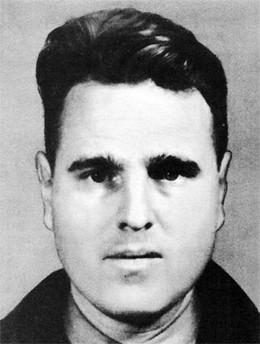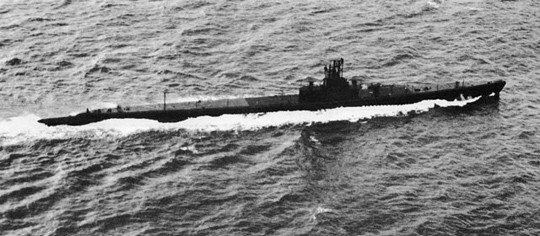
The Navy Department Library
Robalo (SS 273)
Robalo under Commander M.M. Kimmel, departed Fremantle on 22 June 1944 to conduct her third war patrol in the South China Sea in the vicinity of the Natuna Islands. After traversing Makassar and Balabac Straits, she was to arrive on station about 6 July, and stay there until dark on 2 August 1944.
On 2 July a contact report stated Robalo had sighted a Fuso-class battleship with air cover and two destroyers for escort in 3°-29'N, 119°-26'E, just east of Borneo. No other messages were received from Robalo and when she did not return from patrol, she was reported as presumed lost.
The following information was received via the Philippine guerrillas and a U.S. Navy enlisted man who was a prisoner of war at Puerto Princesa Prison Camp, Palawan, Philippine Islands. On 2 August 1944, a note dropped from the window of the prison cell in which survivors from Robalo were held was picked up by an American soldier in a work detail and given to H.D. Hough, Y2c, USN, another prisoner. On 4 August, Hough contacted Mrs. Trinidad Mendosa, wife of guerrilla leader Dr. Mendosa, who furnished further information on the survivors. From these sources, he put together the following facts:
Robalo was sunk 26 July 1944, two miles off the western coast of Palawan Island as a result of an explosion of her after battery. Four men swam ashore, an officer and three enlisted men: Samuel L. Tucker, Ensign; Floyd G. Laughlin, QMlc; Wallace K. Martin, SM3c, and Mason C. Poston, EM2c. They made their way through the jungles to a small barrio northwest of the Puerto Princesa camp. They were captured there by Japanese Military Police, and confined in the jail. They were held for guerrilla activities rather than as prisoners of war, it is said. On 15 August 1944, they were evacuated by a Japanese destroyer, and nothing further is known of their destination or whereabouts. They may have been executed by the Japanese or the destroyer may have been sunk. At any rate, they were never recovered and their note stated that there were no other survivors.
It is doubted that a battery explosion could be sufficiently violent to cause the sinking of the ship; more likely Robalo struck an enemy mine.
In her first patrol, in the area west of the Philippines, Robalo damaged a large enemy freighter. Her second patrol was in the South China Sea near Indo-China where she sank a 7,500-ton tanker.
--100--

| U.S.S. Robalo (SS-273) | ||||
| Name | Rate | Name | Rate | |
Ackley, James W. |
S1 |
|
Leahey, Richard J. |
SC3 |
Note: * Survived the sinking, but did not survive the war. Last seen aboard a Japanese destroyer. |
||||
--101--





